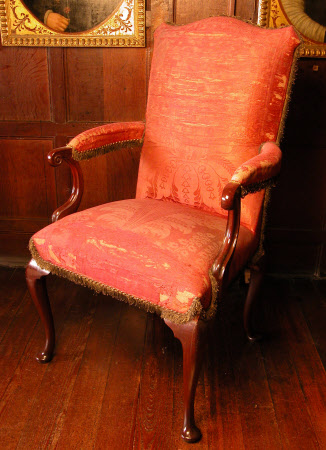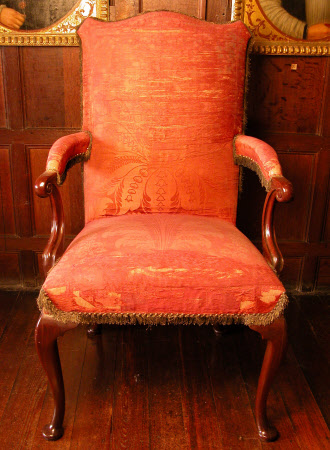Chair
John Russell (c.1773-1822)
Category
Furniture
Date
1783
Materials
Carved and polished walnut and beech upholstered in crimson silk damask
Measurements
129.5 x 74.0 x 61.0 cm
Place of origin
London
Order this imageCollection
Knole, Kent
NT 129410
Caption
The young and dashing 3rd Duke of Dorset was the penultimate British ambassador at the court of Louis XVI and Marie-Antoinette before the French Revolution. He became good friends with the queen, whom he affectionately referred to as ‘Mrs B’ after the royal house of Bourbon. Ambassadors were seen as personal representatives of the King and as such they were provided with a conspicuously splendid equipage. This typically included silver, a portrait of the sovereign, a state canopy as well as a chair of state with a pair of stools, a footstool and a dais. Dorset was no exception. His canopy, which was later converted into a four-post bed, was embroidered in high relief with the royal arms. He was provided with full-length portraits of George III and Queen Charlotte in carved and gilded frames. Perhaps most extravagant, his service of silver was exceptionally elaborate, comprising 12 dozen engraved plates. But what about his chair of state? This cabriole-legged chair, supplied by John Russell, chairmaker to George III, was glaringly old-fashioned, even in the Duke of Dorset’s time. Its plain shape and the overall lack of carving and gilding was reminiscent of earlier and simpler furniture. It’s interesting to note that while Dorset did not complain about the archaic design of his chair of state, one of his contemporaries, George Hervey, 2nd Earl of Bristol and ambassador to Madrid, did. Bristol requested that he only be given crimson damask to be used in a more elaborate ambassadorial throne he planned to commission from Spanish craftsmen.
Summary
A polished walnut chair of state on cabriole legs, stuffed seat, back and arms upholstered in crimson silk damask; the damask and fringe apparently applied over cherry coloured velvet. As Martin Drury explains, it was customary, until about 1830, for British ambassadors ‘to be equipped at the expense of the sovereign with an allowance of plate, a portrait of the sovereign, a state canopy, a chair, two stools, a foot stool and chapel furnishings’ (Drury 1985). This chair of state, stylistically archaic, comes en suite with two stools (NT 129411.1-2). The set may either be the one supplied by John Russell to the George Montagu, 4th Duke of Manchester, British Ambassador to the court of Louis XVI in 1783 or to his successor, John Sackville, 3rd Duke of Dorset (Ambassador from 1783-1789). Because the Duke of Manchester’s embassy was so short lived, it is likely that Dorset took over his furniture. Manchester’s chair is recorded to have been supplied by John Russell, joiner and chairmaker, who also supplied the chair of state for Lord Whitworth, appointed Ambassador to Paris in 1802, and also preserved at Knole (NT 129592). ‘On the inner face of the seat rail of the chair are inscribed [in ink] the words: “Fryer July 1783”. Fryer is probably the name of the craftsman in Russell’s workshop who made the chair’ (Drury 1985).
Provenance
Possibly supplied by John Russell, joiner and chairmaker, to George Montagu, 4th Duke of Manchester in 1783 and used by John Sackville, 3rd Duke of Dorset in his capacity of British Ambassador to the court of Louis XVI from 1783 to 1789. Knole and the majority of its furniture were accepted by HM Treasury in part payment of death duties and transferred to the National Trust in 1946.
Makers and roles
John Russell (c.1773-1822), joiner Fryer, chairmaker
References
Drury, 1985: Martin Drury. “Two Georgian chairs of state and a state canopy at Knole.” Furniture History 21 (1985): pp.243-9. Rowell and Burchard 2016a: Christopher Rowell and Wolf Burchard, 'From Knole to Paris: The third Duke of Dorset and the first Earl Whitworth as diplomatic Patrons and Collectors', National Trust Historic Houses & Collections Annual/Apollo (2016): 43-52.

